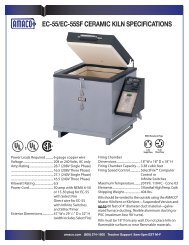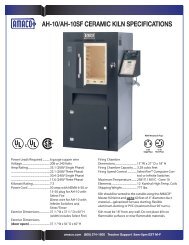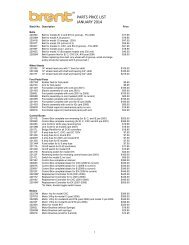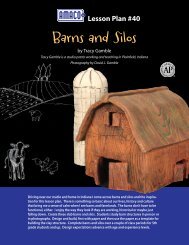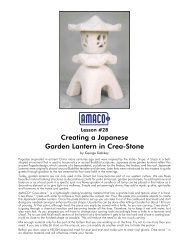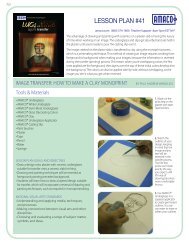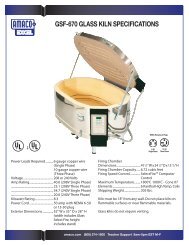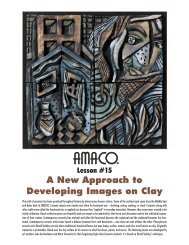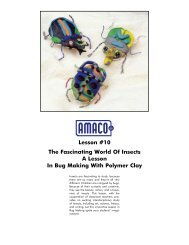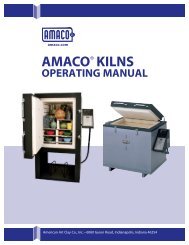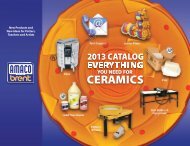Create successful ePaper yourself
Turn your PDF publications into a flip-book with our unique Google optimized e-Paper software.
<strong>LESSON</strong> <strong>PLAN</strong> <strong>#31</strong><br />
amaco.com (800) 374-1600 Teacher Support 8am-5pm EST M-F<br />
Sculpted, Painted balsa-foam ® African masks By Michelle Zimmerman<br />
Lesson Goals and Objectives:<br />
Carve and paint an African mask from<br />
Balsa Foam ® . Then each student can<br />
create a personal 'cultural' mask.<br />
This project is suitable for grades 5-8.<br />
National Visual Art Standards Addressed:<br />
1. Understanding the visual arts in relation to<br />
history and culture.<br />
2. Understanding and applying media,<br />
techniques, and processes.<br />
3. Using knowledge of structures and<br />
functions.<br />
4. Choosing a range of subject matter,<br />
symbols, and ideas.<br />
5. Reflecting upon and assessing the<br />
characteristics of artwork.<br />
6. Making connections between visual arts<br />
and other disciplines.<br />
Materials & tools<br />
Materials<br />
• Small pieces of AMACO Balsa-Foam ®<br />
• Acrylic paints such as Folk Art or Americana<br />
brands Gesso<br />
Tools<br />
• AMACO ® EZ Grip Modeling tools (11139A)<br />
• AMACO ® Needle tool (70488R)<br />
• AMACO ® Clean-Up Tool (11135V or 11138Y)<br />
• AMACO ® Double-Ended Stylus (11141C)<br />
• AMACO ® Sgraffito Tool & Duster (11147A)<br />
• Soft pencil<br />
• Emery board or sand paper<br />
• Paint brush<br />
• Palette
Sculpted, Painted African masks techniQUE<br />
Preparation<br />
1. If you have a large piece of Balsa-Foam® cut it into smaller pieces for the masks.<br />
Our masks are all less than 3" in height and less than 1" deep.<br />
Younger students can use the EZ Grip Modeling tools for carving the BalsaFoam®.<br />
Older students can use the clay tools specified and the AMACO® Needle metal tool for carving.<br />
A suggested class project involves students researching different African cultures and carving three<br />
different masks representing the cultures they have studied. Students should explain how<br />
the masks they have carved reflect the cultures they have studied.<br />
Students can then use a 4th small block of Balsa-Foam® to carve their own cultural mask and<br />
explain the importance of the symbols they have used in their design.<br />
Carve a mask<br />
2. Sketch the design you plan to make.<br />
Using a pencil, draw an outline of the mask profile onto the side of a small block of Balsa-Foam®.<br />
Draw an outline of the front of the design on the front of the block and a rear outline on the back<br />
of the block.<br />
Carving involves making a decision about the surface you remove and the surface you leave<br />
behind. The sketched outlines will help you determine what to carve away and what to leave.<br />
Start by removing the unwanted larger areas around your shape, referencing the outlines you<br />
have drawn. Once you have the initial shape, start carving the details into the mask.<br />
Work carefully and continually check against your drawing to ensure correct positioning of<br />
elements on the mask. Continue to work the shape taking less away each time as you develop<br />
increasingly smaller details in the mask.<br />
3. When you are happy with your design, coat it with a thin coat of Gesso to seal it and set<br />
aside to dry.<br />
4. Using acrylic paint colors of your choice paint your mask with a very light coat of paint.<br />
If you do this, the texture of the Balsa-Foam® will still be visible giving it a very interesting surface.<br />
For more ideas, visit our Craft Library at amaco.com



